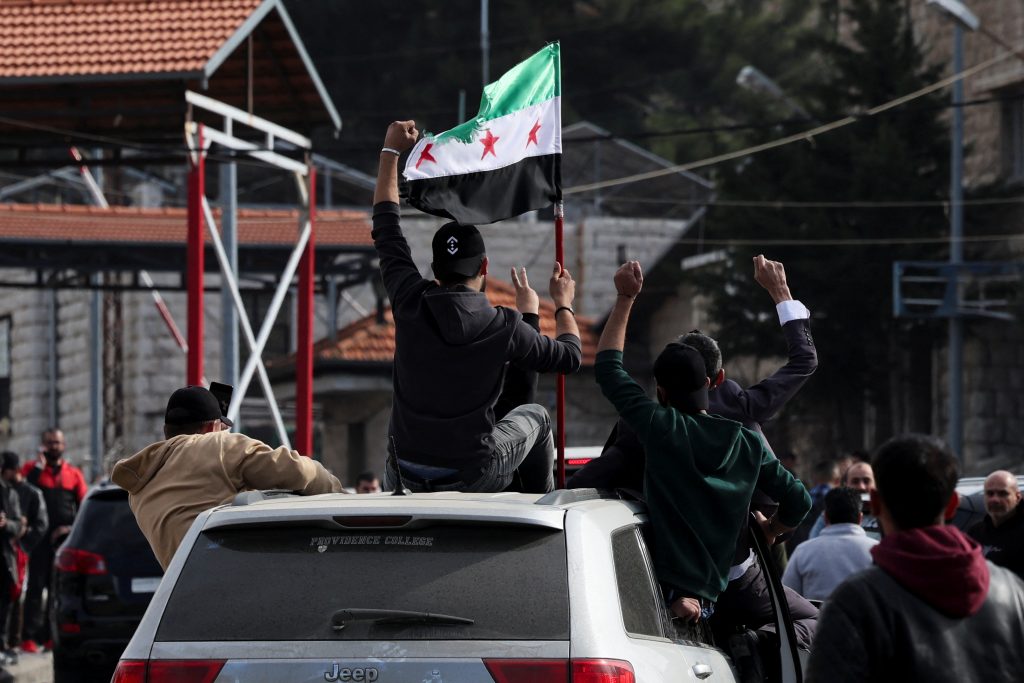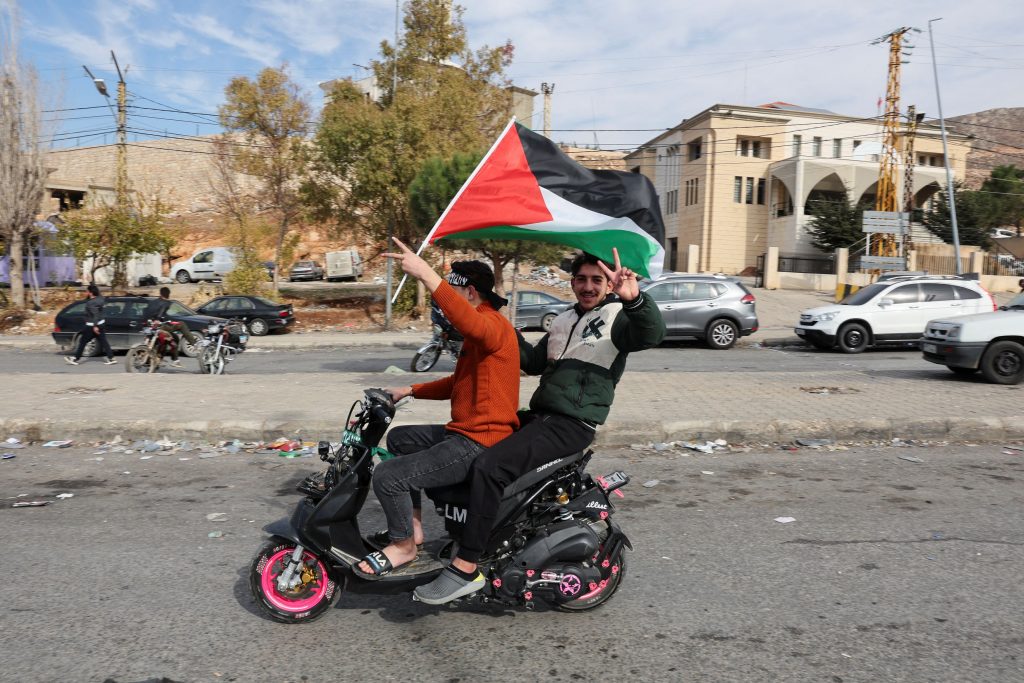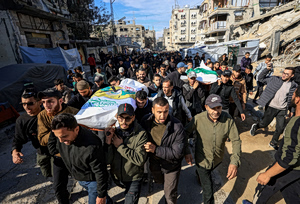In little over a week, Syrian rebel groups have rolled across Syria, routing government forces and pushing the Assad family’s half-a-century rule to the brink of collapse.
Early Sunday, the rebels said they had liberated the capital, Damascus, from the rule of President Bashar al-Assad, who fled as they closed in, Syrian security officials said.
Islamist rebels launched a large-scale attack on government forces at the end of November, causing the largest shift in the balance of power since 2020 in the country, where more than a decade of war has taken place. Battling Iran- and Russian-backed regime forces, within days the rebels in a lightning offensive had captured Aleppo, which was Syria’s largest city before the war, before advancing south to take the strategic cities of Hama and Homs. Here’s what to know.

People celebrate from a vehicle while carrying a Syrian opposition flag at Masnaa Border Crossing, after Syrian rebels announced that they have ousted President Bashar al-Assad, Lebanon, December 8, 2024. REUTERS/Amr Abdallah Dalsh
What has happened so far in Syria’s civil war?
The war broke out in 2011, when Assad’s regime violently suppressed protests that had spread across the country during the Arab Spring. That triggered an armed insurrection against the government, parts of which morphed into an Islamist uprising.
The northern city of Aleppo was a center of that armed rebellion, and the opposition forces claimed parts of the city in 2012. It took the Syrian regime four years, with military support from Iran and its allies and later Russian air power, to oust rebels from their strongholds in Aleppo. While Assad’s forces eventually clawed back control over much of the territory, several rebel groups maintained control of parts of the divided country.
Who is fighting whom?
The rebels fighting the Assad regime are backed by Turkey and are largely made up of Sunnis. The main rebel group, Hayat Tahrir al-Sham, is a Sunni Islamist group that the Trump administration designated as a terrorist organization in 2018. Some rebel groups are backed by Turkey.
Meanwhile, Russia and Shiite Iran have backed Assad. But in the wake of the rebel offensive, both Russia and Iran signaled to the Syrian leader that they couldn’t or wouldn’t intervene to save his regime, according to people familiar with U.S. intelligence analysis. In the wider Middle East, Iran and its allies are competing for power and influence against Sunni states, including the Saudi monarchy. Within Syria, Assad has drawn his support from the minority Alawite sect. In the northeast, Western countries have supported Kurdish fighters, which Turkey opposes.
Why has the war intensified?
The surprise rebel offensive is, in part, a consequence of new wars that have erupted outside Syria’s borders, leaving Assad’s allies—Iran, Russia and the Lebanese Hezbollah militia—weakened and distracted. The rebels also took advantage of disaffection in the Syrian military, which is filled with badly paid soldiers.

People make their way as they attempt to cross into Syria after Syrian rebels announced that they have ousted President Bashar al-Assad, near Masnaa Border Crossing, Lebanon, December 8, 2024. REUTERS/Amr Abdallah Dalsh
Who are the rebels and their backers?
Hayat Tahrir al-Sham is an offshoot of the Nusra Front, a onetime affiliate of al Qaeda, and is funded by Turkey. The group has run a statelet of its own in Syria’s northern Idlib province in recent years. Abu Mohammed al-Jawlani, the leader of the group, has turned it into a disciplined fighting force, with an ideology that blends Islamism and nationalism.
Turkey has historically backed the opposition against Assad since the start of the 2011 uprising against him, and now it supports some Syrian rebel groups in its own fight against Kurdish militants on its southern border.
Are the rebels linked to Islamic State?
Jawlani, the HTS leader, broke with Islamic State in 2012. He cut ties with al Qaeda in 2016, and since then has fought both organizations in bloody campaigns. Instead of the banner of Islam, HTS troops choose to fight under the Syrian flag that dates back to the republic that existed before the 1963 Baath Party revolution that eventually brought the Assad family to power.
What role does the U.S. play?
The U.S. has sanctioned the Assad regime for using chemical weapons against civilians during the conflict, among other things. The first Trump administration launched airstrikes against Syrian military assets in 2018.
The U.S., which maintains a force of around 900 troops in southeast Syria to defend against Islamic State fighters, has supported the Kurds in northern Syria but has said it has nothing to do with the rebel offensive and has called for a de-escalation. U.S. officials fear getting dragged deeper into the conflict if its troops stationed there are attacked, or if the U.S.-backed Syrian Democratic Forces is targeted by Turkey.
On Saturday, President-elect Donald Trump posted on social media that the U.S. should stay out of the war in Syria.

People, carrying a Palestinian flag, celebrate as they ride a scooter near Masnaa Border Crossing, after Syrian rebels announced that they have ousted President Bashar al-Assad, Lebanon, December 8, 2024. REUTERS/Amr Abdallah Dalsh
Who supports the Syrian government?
Russia and Iran, longtime supporters of Assad in the civil war, have come to his aid since the most recent rebel assault began but didn’t come to his rescue this past week as they did in 2015, when they helped him crush an uprising with air power and proxy forces. Russia is occupied with its war effort in Ukraine, while Iran and the militias it backs have been hammered by an Israeli air and ground campaign in Lebanon and strikes in Syria in recent months.
Tehran told Assad earlier this week that help for his regime would be limited, blaming his forces for retreating, Arab officials briefed on the conversations said. People familiar with the matter said Iran had pulled senior commanders stationed in eastern Syria out of the country.

People celebrate, after Syrian rebels announced that they have ousted President Bashar al-Assad, in Tripoli, northern Lebanon December 8, 2024. REUTERS/Omar Ibrahim
Will Assad’s regime fall?
The Assad family has clung to power for half a century, surviving by brutally suppressing uprisings and working with allies to fight rebellions. The rebels’ advance on Damascus, following their seizure of Aleppo, Hama and Homs puts Assad in the most precarious position of his 24-year rule. Assad, who was in Damascus on Saturday, fled to an unknown destination early on Sunday, local time, Syrian security officials said.
Assad had announced he would address the nation at 8 p.m. local time on Saturday, but the speech never occurred.
As Assad’s forces scrambled to defend core strategic areas, its hold on other parts of the country also appeared to be weakening. Rebels claimed to have seized another city in the south, Daraa, where the Syrian revolution started in 2011.
This explanatory article may be periodically updated.
Summer Said contributed to this article.
Write to Jared Malsin at jared.malsin@wsj.com


